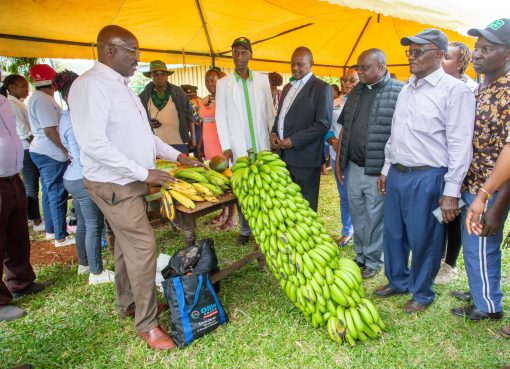The County government of Nakuru has rolled out a new marketing information system designed to help farmers identify marketing opportunities and negotiate for better prices.
The system dubbed ‘Kenya Agricultural Marketing Information System'(KAMIS) is also aimed at guiding the devolved unit in making legislations, regulations and policies with regard to agricultural and marketing activities.
KAMIS also hopes to rein in middlemen who have been exploiting small holder growers, as the database is tailor made to provide farmers with easier access to timely and accurate information on prices and market conditions.
County Executive Committee Member for Agriculture, Livestock and Fisheries Dr. Immaculate Maina said KAMIS will initially be linked to six major markets before being up scaled to cover other agricultural produce outlets in all the 11 sub-counties.
“Farmers’ economic returns are determined by the nature of information at their disposal during farm production and marketing. This system will also provide small scale farmers with relevant information on appropriate farming methods and output marketing,” noted Dr Maina
The six major markets that will initially be linked to the system are Wakulima market, Top market, Naivasha market, Molo market, Bahati market and Njoro market.
It will also be a platform for agriculture-related information such as weather forecast, prices of inputs such as seed and fertilizers, transport facilities, information on storage facilities and quantities and volumes traded at selected markets in the County, and across borders.
“In some areas farmers have been relying on brokers to provide market information for their farm produce.
Owing to vested interests by middlemen they provide farmers with distorted information and buy their produce at lower than market value. Easy access to relevant, up to date and adequate market information is the biggest driver of agricultural profitability,” noted the CEC.
She said the system which is targeting over 300,000 small holder growers and other stakeholders will enable farmers make informed decisions on the time to produce different crops and in what quantities in order to maximize returns.
“Information on price fluctuations will also give insights into the risks associated with producing different crops. Consequently, better information is expected to lead to higher profitability” stated Dr. Maina.
County Executive Committee Member for Trade Mr. Raymond Komen said improved information will enable farmers to align their activities with market demand, schedule their harvests at the most profitable time and make good decisions on which markets they should send their produce.
He said the KAMIS data base will also guide the County government in rationalizing existing policies on service delivery, regulation, taxation and marketing among others.
Mr Komen noted that it will also furnish the devolved unit’s administration with information on availability of food commodities with regard to the Big 4 Agenda on Food Nutrition and Security.
“Market information will offer the opportunity for policy makers to judge the performance of markets for agricultural products and to determine micro-economic constraints. The data base will serve as an early warning of food shortages and in the management of food security reserves,” said the Trade CEC.
County Team Leader for KAMIS Mr. Benjamin Kibor said ten officials from various sub-counties had been trained on application of the system which he said will assist the county government in bringing about a wide-ranging change in the agricultural marketing subsector, with the aim of making rural markets work better and empowering smallholders within the markets.
He said KAMIS will strengthen the capacity of the devolved unit to collect, compile and disseminate agricultural marketing information, contribute improved marketing efficiency and enable small holder farmers have a better bargaining position.
“The system is engineered to establish and strengthen vertical and horizontal linkages among small holder farmers, grass-roots institutions, processors, local marketing chains and exporters.
We will make continuous improvements to the system that will in future enable small scale farmers, grass-roots institutions, traders and processors access inventory and capital loans from commercial banks, when needed for promoting marketing activities,” observed the KAMIS team leader.
Mr Kibor observed that KAMIS will bolster improvement of public policies through an increased awareness of market realities, enhance market transparency and bring about a fairer and more efficient allocation of resources.
“Improved information will enable small scale farmers negotiate on a more even footing with traders. It plays a crucial role in reducing the risk of losing money on a market transaction.
Farmers with information can decide whether or not to harvest and sell their products in times of glut. Accurate and timely information should reduce the costs of food marketing,” said the KAMIS team leader.
By Anne Mwale




